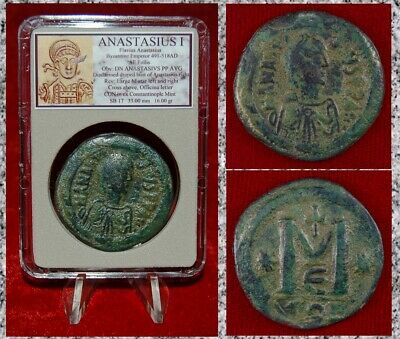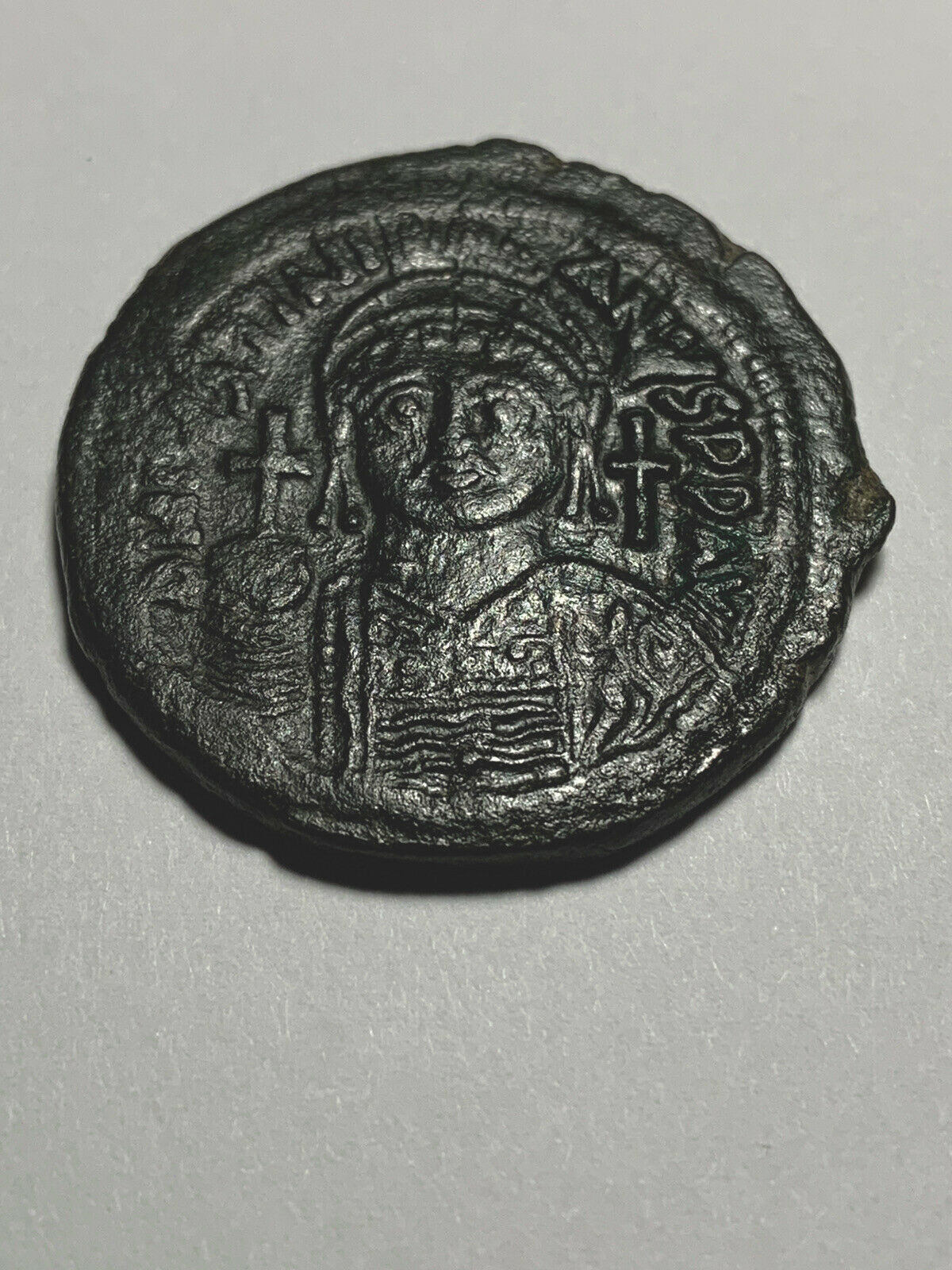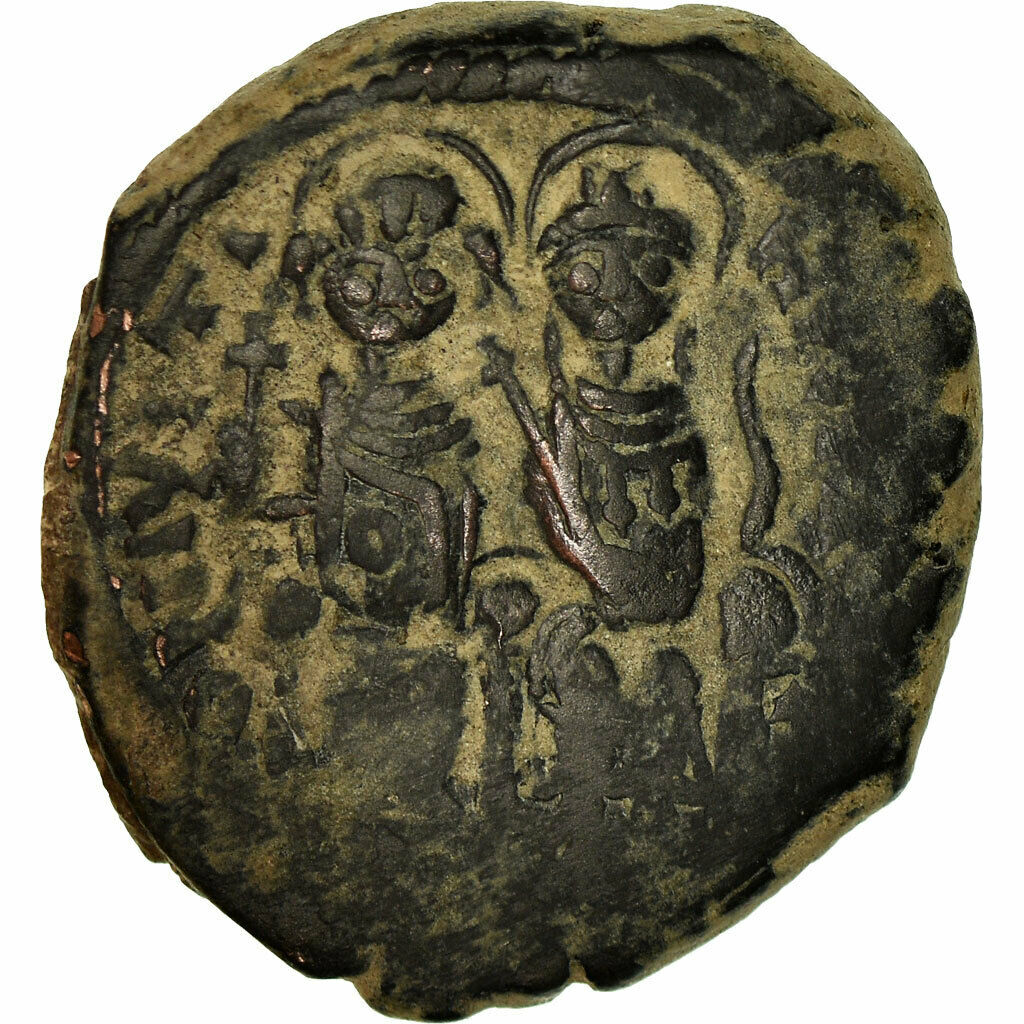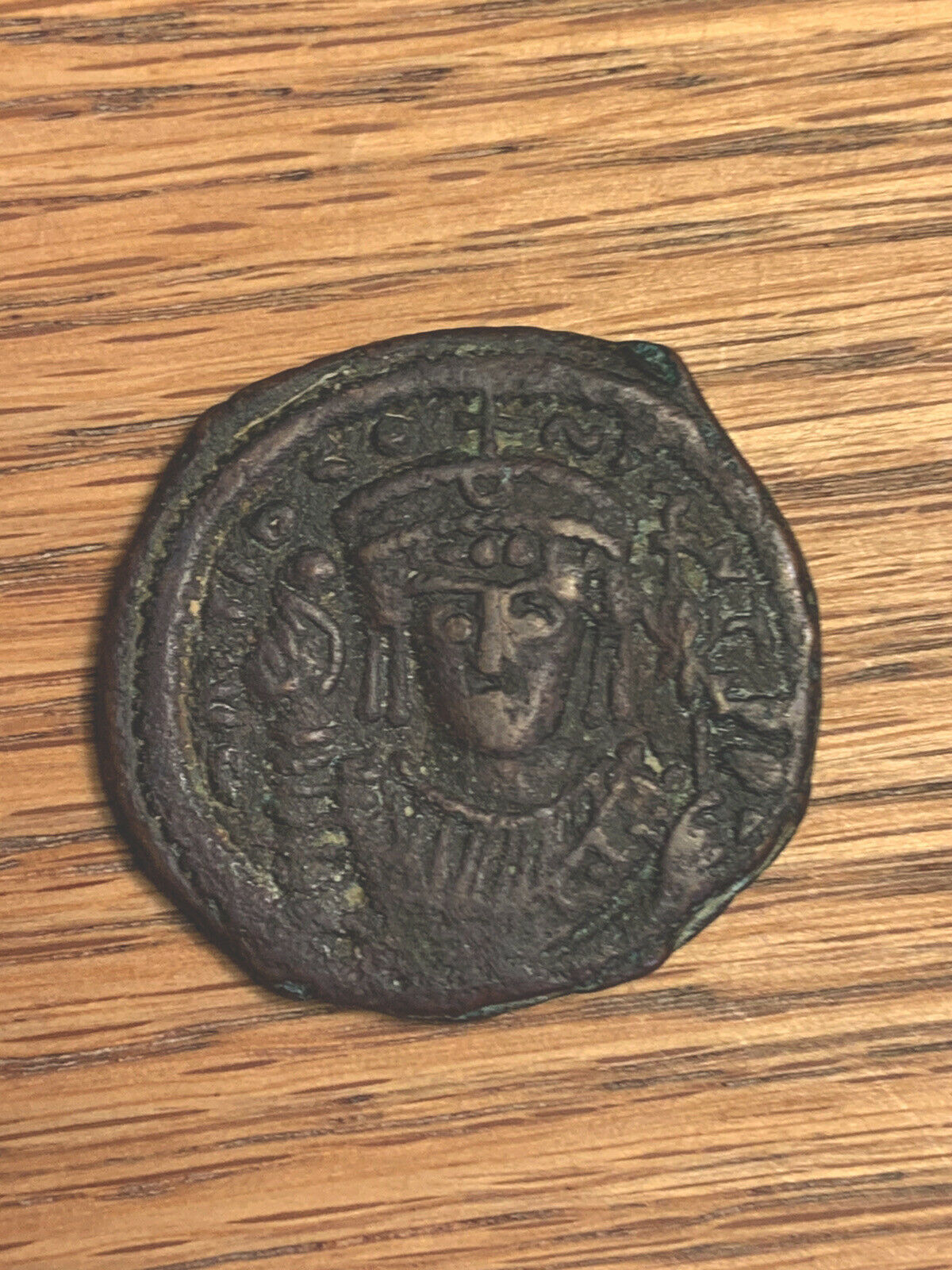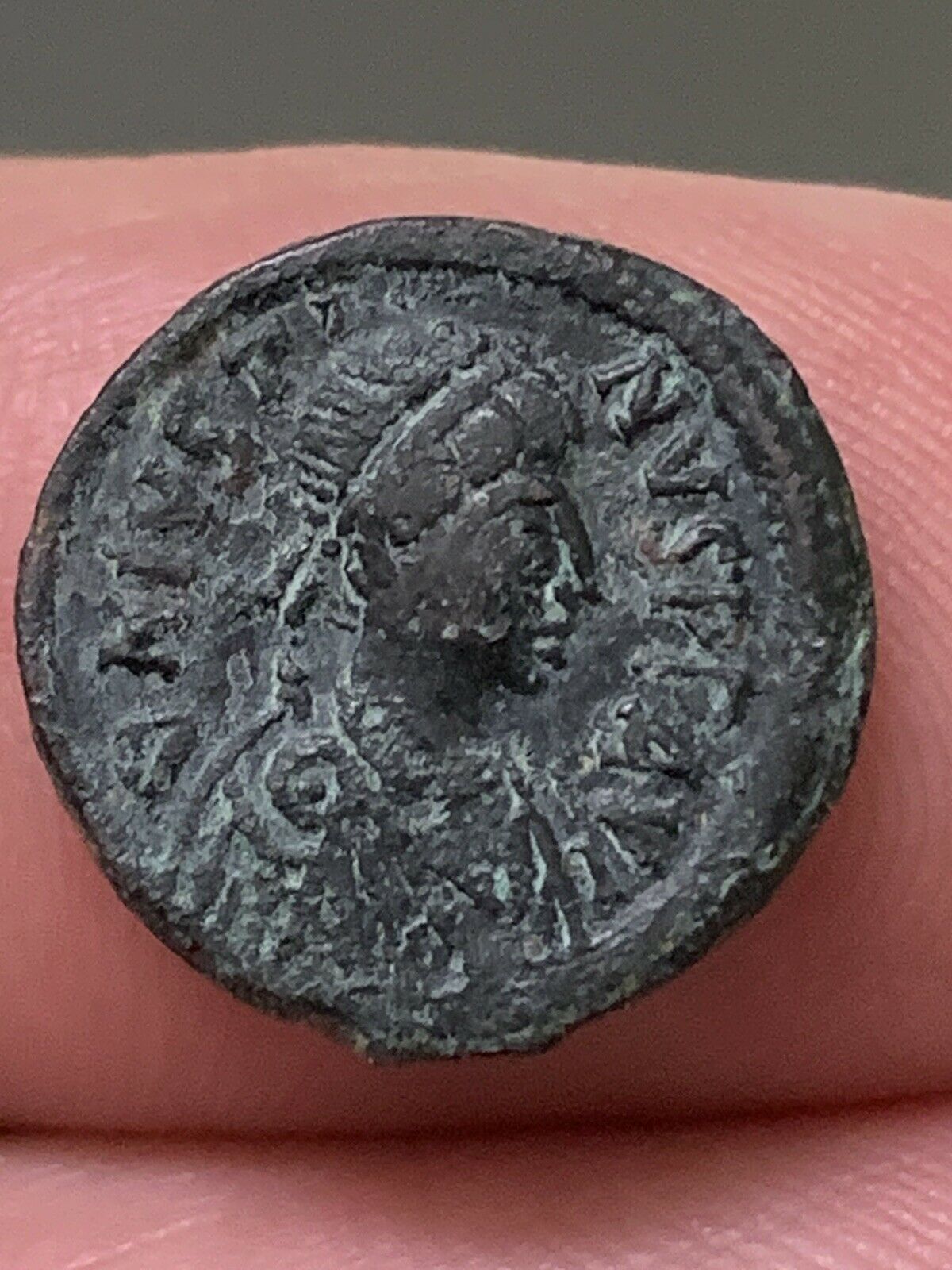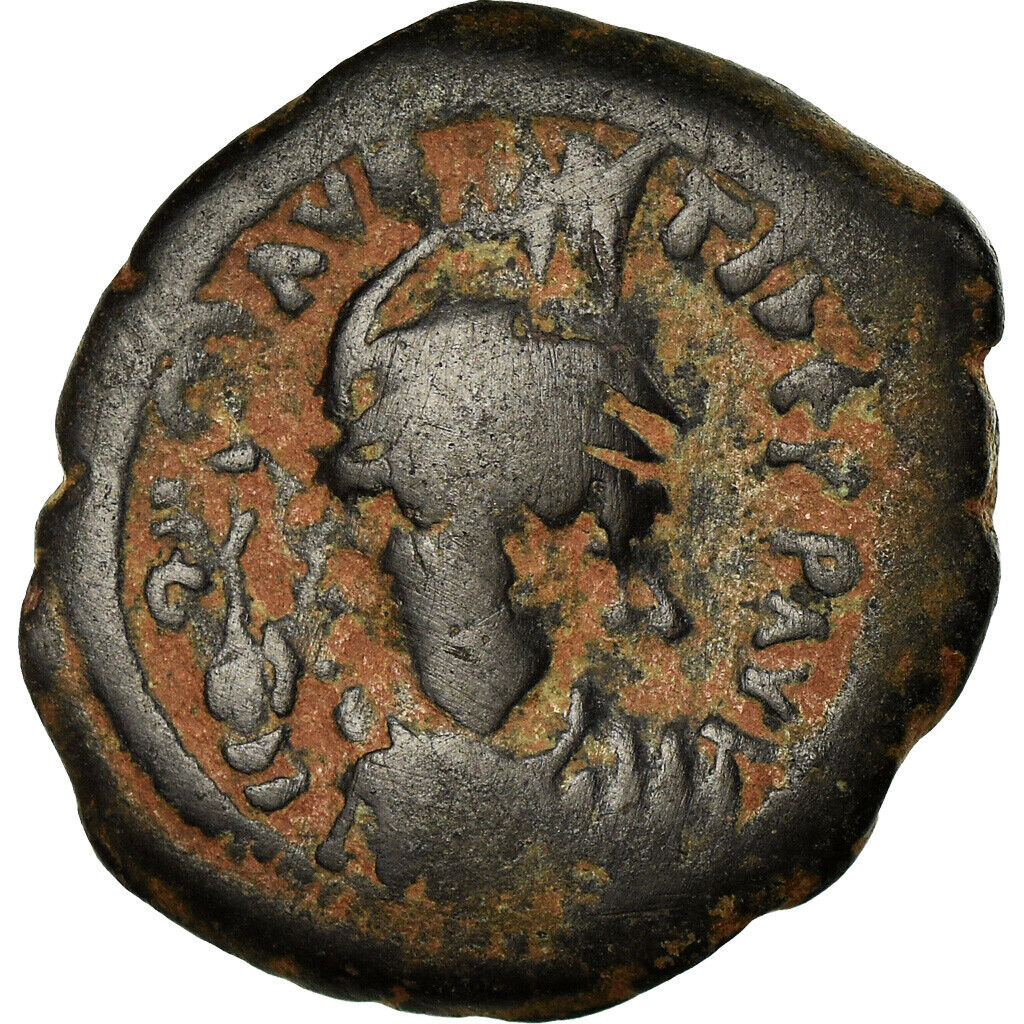-40%
Ancient Byzantine Empire Coin ANASTASIUS I Beautiful Large Bronze Bronze!
$ 44.35
- Description
- Size Guide
Description


BYZANTINE EMPIRE
Ancient Coin
AE Bronze Follis
ANASTASIUS I
Flavius Anastasius
Byzantine Emperor 491-518AD
Obv: DN ANASTASIVS PP AVG
Diademed draped bust of Anastasius I right
Rev: Large M
Cross abpve, Officina letter
Constantinople Mint
33.00 mm
PRIVATE
ANCIENT COINS COLLECTION
SOUTH FLORIDA ESTATE SALE
( Please, check out other ancient coins we have available for sale. We are offering 1000+ ancient coins collection)
ALL COINS ARE GENUINE
LIFETIME GUARANTEE
AND PROFESSIONALLY ATTRIBUTED
The attribution label is printed on archival museum quality paper
An interesting large Byzantine coin of Anastasius I. Bust of Anastasius I
on obverse and large M on reverse. This coin comes with display case, stand and attribution label attached as pictured.
A great way to display an ancient coins collection. You are welcome to ask any questions prior buying or bidding. We can ship it anywhere within continental U.S. for a flat rate of 6.90$. It includes shipping, delivery confirmation and packaging material.
Limited Time Offer:
FREE SHIPPING
(only within the continental U.S.)
The residents of HI/AK/U.S. Territories and International bidders/buyers must contact us for the shipping quote before bidding/buying
ANASTASIUS I
Anastasius I (Latin: Flavius Anastasius Dicorus Augustus,
c. 431 – 9 July 518) was Byzantine Emperor from 491 to 518. During his reign the Roman eastern frontier underwent extensive re-fortification, including the construction of Dara, a stronghold intended to counter the Persian fortress of Nisibis. During his reign, one of the most fortified castle cities on the Adriatic, Durrës Castle in Durrës, was constructed.
Background and personal characteristics
Anastasius was born at Dyrrhachium in the Latin-speaking part of the Balkans; the date is unknown, but he is thought to have been born no later than 430 or 431. He was born into an Illyrian family,[1] the son of Pompeius (born c. 410), nobleman of Dyrrachium, and wife Anastasia Constantina (born c. 410). His mother was an Arian, sister of Clearchus, also an Arian, and a paternal granddaughter of Gallus (born c. 370), son of Anastasia (born c. 352) and husband, in turn daughter of Flavius Claudius Constantius Gallus and wife and cousin Constantina.
Accession:
At the time of the death of Zeno (491), Anastasius, a palace official (silentiarius), held a very high character, and was raised to the throne of the Eastern Roman Empire by Ariadne, Zeno's widow, who preferred him to Zeno's brother, Longinus.
Ariadne married him shortly after his accession on 20 May 491. His reign, though afterwards disturbed by foreign and internecine wars and religious distractions, commenced auspiciously. He gained the popular favour by a judicious remission of taxation, and displayed great vigour and energy in administering the affairs of the Empire.
Foreign policy and wars:
Anastasius engaged in the Isaurian War against the usurper Longinus and the Anastasian War against Sassanid Persia.
The Isaurian War (492-497) was stirred up by the Isaurian supporters of Longinus, the brother of Zeno who was passed over in his succession in favor of Anastasius. The battle of Cotyaeum in 492 "broke the back" of the revolt, but guerrilla warfare continued in the Isaurian mountains for some years longer.
In the Anastasian War (502–505), Theodosiopolis and Amida were captured by the Sassanids, but Persian provinces also suffered severely and the Byzantines recovered Amida. Both adversaries were exhausted when peace was made in 506 on the basis of the status quo. Anastasius afterwards built the strong fortress of Daras to hold the Persians in check in Nisibis. The Balkan provinces were left denuded of troops, however, and were devastated by invasions of Slavs and Bulgars; to protect Constantinople and its vicinity against them, the emperor built the Anastasian Wall, extending from the Propontis to the Euxine.
Domestic and ecclesiastical policies:
The Emperor was a convinced Miaphysite, following the teachings of Cyril of Alexandria and Severus of Antioch who taught "One Incarnate Nature of Christ" in an undivided union of the Divine and human natures, but his ecclesiastical policy was moderate; he endeavoured to maintain the principle of the Henotikon of Zeno and the peace of the church. It was rebellious demonstrations of the Byzantine populace, that drove him in 512 to abandon this policy and adopt Miaphysitic programme. His consequent unpopularity in the European provinces was utilized by an ambitious man, named Vitalian, to organize a dangerous rebellion, in which he was assisted by a horde of "Huns" (514–515); it was finally suppressed by a naval victory won by the general Marinus.
Successor:
The Anonymous Valesianus tells an account about his choosing of a successor: Anastasius could not decide which of his three nephews should succeed him, so he put a message under a couch and had his nephews take seats in the room, which also had two other seats; he believed that the nephew to sit on the special couch would be his proper heir. However, two of his nephews sat on the same couch, and the one with the concealed message remained empty.
Then, after putting the matter to God in prayer, he determined that the first person to enter his room the next morning should be the next Emperor, and that person was Justin, the chief of his guards. In fact, Anastasius probably never thought of Justin as a successor, but the issue was decided for him after his death. At the end of his reign, he left the Imperial treasury richer by 23,000,000 solidi or 320,000 pounds of gold.
Anastasius died childless in Constantinople on 9 July 518 (some sources say 8 or 10 July) and was buried at the Church of the Holy Apostles.
Family:
Anastasius is known to have had a brother named Flavius Paulus, who served as Roman consul in 496.A sister-in-law, known as Magna, was mother to Irene and mother-in-law to Olybrius. This Olybrius was son of Anicia Juliana and Areobindus Dagalaiphus Areobindus. The daughter of Olybrius and Irene was named Proba. She married Probus and was mother to a younger Juliana. This younger Juliana married another Anastasius and was mother of Areobindus, Placidia, and a younger Proba. Another nephew of Anastasius was Flavius Probus, Roman consul in 502. Caesaria, sister of Anastasius, married Secundinus. They were parents to Hypatius and Pompeius. Flavius Anastasius Paulus Probus Moschianus Probus Magnus, Roman Consul in 518 also was a great-nephew of Anastasius. His daughter Juliana later married Marcellus, a brother of Justin II. The extensive family may well have included viable candidates for the throne.
Byzantine Empire coinage reform:
The main elements of the complex monetary system of the early Byzantine Empire, which suffered a partial collapse in the 5th century, were revived by Emperor Anastasius I (491–518) in 498. The new system involved three denominations of gold (the solidus and its half and third) and five of copper (the follis, worth 40 nummi and its fractions down to a nummus).
BYZANTINE EMPIRE
The Byzantine Empire was a vast and powerful civilization with origins that can be traced to 330 A.D., when the Roman emperor Constantine I dedicated a “New Rome” on the site of the ancient Greek colony of Byzantium. Though the western half of the Roman Empire crumbled and fell in 476 A.D., the eastern half survived for 1,000 more years, spawning a rich tradition of art, literature and learning and serving as a military buffer between Europe and Asia. The Byzantine Empire finally fell in 1453, after an Ottoman army stormed Constantinople during the reign of Constantine XI.
Byzantium
The term “Byzantine” derives from Byzantium, an ancient Greek colony founded by a man named Byzas. Located on the European side of the Bosporus (the strait linking the Black Sea to the Mediterranean), the site of Byzantium was ideally located to serve as a transit and trade point between Europe and Asia.
In 330 A.D., Roman Emperor Constantine I chose Byzantium as the site of a “New Rome” with an eponymous capital city, Constantinople. Five years earlier, at the Council of Nicaea, Constantine had established Christianity — once an obscure Jewish sect — as Rome’s official religion.
The citizens of Constantinople and the rest of the Eastern Roman Empire identified strongly as Romans and Christians, though many of them spoke Greek and not Latin.
Byzantine Empire Flourishes
The eastern half of the Roman Empire proved less vulnerable to external attack, thanks in part to its geographic location.
With Constantinople located on a strait, it was extremely difficult to breach the capital’s defenses; in addition, the eastern empire had a much smaller common frontier with Europe.
It also benefited greatly from a stronger administrative center and internal political stability, as well as great wealth compared with other states of the early medieval period. The eastern emperors were able to exert more control over the empire’s economic resources and more effectively muster sufficient manpower to combat invasion.
Eastern Roman Empire
As a result of these advantages, the Eastern Roman Empire, variously known as the Byzantine Empire or Byzantium, was able to survive for centuries after the fall of Rome.
Though Byzantium was ruled by Roman law and Roman political institutions, and its official language was Latin, Greek was also widely spoken, and students received education in Greek history, literature and culture.
In terms of religion, the Council of Chalcedon in 451 officially established the division of the Christian world into separate patriarchates, including Rome (where the patriarch would later call himself pope), Alexandria, Antioch and Jerusalem.
Even after the Islamic empire absorbed Alexandria, Antioch and Jerusalem in the seventh century, the Byzantine emperor would remain the spiritual leader of most eastern Christians.
Iconoclasm
During the eighth and early ninth centuries, Byzantine emperors (beginning with Leo III in 730) spearheaded a movement that denied the holiness of icons, or religious images, and prohibited their worship or veneration.
Known as Iconoclasm—literally “the smashing of images”—the movement waxed and waned under various rulers, but did not end definitively until 843, when a Church council under Emperor Michael III ruled in favor of the display of religious images.
Byzantine Art
During the late 10th and early 11th centuries, under the rule of the Macedonian dynasty founded by Michael III’s successor, Basil, the Byzantine Empire enjoyed a golden age.
Though it stretched over less territory, Byzantium had more control over trade, more wealth and more international prestige than under Justinian. The strong imperial government patronized Byzantine art, including now-cherished Byzantine mosaics.
Rulers also began restoring churches, palaces and other cultural institutions and promoting the study of ancient Greek history and literature.
Greek became the official language of the state, and a flourishing culture of monasticism was centered on Mount Athos in northeastern Greece. Monks administered many institutions (orphanages, schools, hospitals) in everyday life, and Byzantine missionaries won many converts to Christianity among the Slavic peoples of the central and eastern Balkans (including Bulgaria and Serbia) and Russia.
The Crusades
The end of the 11th century saw the beginning of the Crusades, the series of holy wars waged by European Christians against Muslims in the Near East from 1095 to 1291.
With the Seijuk Turks of central Asia bearing down on Constantinople, Emperor Alexius I turned to the West for help, resulting in the declaration of “holy war” by Pope Urban II at Clermont, France, that began the First Crusade.
As armies from France, Germany and Italy poured into Byzantium, Alexius tried to force their leaders to swear an oath of loyalty to him in order to guarantee that land regained from the Turks would be restored to his empire. After Western and Byzantine forces recaptured Nicaea in Asia Minor from the Turks, Alexius and his army retreated, drawing accusations of betrayal from the Crusaders.
During the subsequent Crusades, animosity continued to build between Byzantium and the West, culminating in the conquest and looting of Constantinople during the Fourth Crusade in 1204.
The Latin regime established in Constantinople existed on shaky ground due to the open hostility of the city’s population and its lack of money. Many refugees from Constantinople fled to Nicaea, site of a Byzantine government-in-exile that would retake the capital and overthrow Latin rule in 1261.
Fall of Constantinople
During the rule of the Palaiologan emperors, beginning with Michael VIII in 1261, the economy of the once-mighty Byzantine state was crippled, and never regained its former stature.
In 1369, Emperor John V unsuccessfully sought financial help from the West to confront the growing Turkish threat, but he was arrested as an insolvent debtor in Venice. Four years later, he was forced–like the Serbian princes and the ruler of Bulgaria–to become a vassal of the mighty Turks.
As a vassal state, Byzantium paid tribute to the sultan and provided him with military support. Under John’s successors, the empire gained sporadic relief from Ottoman oppression, but the rise of Murad II as sultan in 1421 marked the end of the final respite.
Murad revoked all privileges given to the Byzantines and laid siege to Constantinople; his successor, Mehmed II, completed this process when he launched the final attack on the city. On May 29, 1453, after an Ottoman army stormed Constantinople, Mehmed triumphantly entered the Hagia Sophia, which would soon be converted to the city’s leading mosque.
The fall of Constantinople marked the end of a glorious era for the Byzantine Empire. Emperor Constantine XI died in battle that day, and the Byzantine Empire collapsed, ushering in the long reign of the Ottoman Empire.
Legacy of the Byzantine Empire
In the centuries leading up to the final Ottoman conquest in 1453, the culture of the Byzantine Empire–including literature, art, architecture, law and theology–flourished even as the empire itself faltered.
Byzantine culture would exert a great influence on the Western intellectual tradition, as scholars of the Italian Renaissance sought help from Byzantine scholars in translating Greek pagan and Christian writings. (This process would continue after 1453, when many of these scholars fled from Constantinople to Italy.)
Long after its end, Byzantine culture and civilization continued to exercise an influence on countries that practiced its Eastern Orthodox religion, including Russia, Romania, Bulgaria, Serbia and Greece, among others.
SHIPPING INFO:
- The Shipping Charge is a flat rate and it includes postage, delivery confirmation, insurance up to the value (if specified), shipping box (from 0.99$ to 5.99$ depends on a size) and packaging material (bubble wrap, wrapping paper, foam if needed)
- We can ship this item to all continental states. Please, contact us for shipping charges to Hawaii and Alaska.
- We can make special delivery arrangements to Canada, Australia and Western Europe.
- USPS (United States Postal Service) is the courier used for ALL shipping.
- Delivery confirmation is included in all U.S. shipping charges. (No Exceptions)
CONTACT/PAYMENT INFO:
- We will reply to questions & comments as quickly as we possibly can, usually within a day.
- Please ask any questions prior to placing bids.
- Acceptable form of payment is PayPal
REFUND INFO:
- All items we list are guaranteed authentic or your money back.
- Please note that slight variations in color are to be expected due to camera, computer screen and color
pixels and is not a qualification for refund.
- Shipping fees are not refunded.
FEEDBACK INFO:
- Feedback is a critical issue to both buyers and sellers on eBay.
- If you have a problem with your item please refrain from leaving negative or neutral feedback until you have made contact and given a fair chance to rectify the situation.
- As always, every effort is made to ensure that your shopping experience meets or exceeds your expectations.
- Feedback is an important aspect of eBay. Your positive feedback is greatly appreciated!
